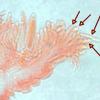
09-01-2026 17:41
Arnold BüschlenHallo, F. dilatata wird von vielen Bryoparasiten

10-01-2026 20:00
Tom SchrierHi all,We found picnidia on Protoparmeliopsis mur

07-01-2026 22:22
 Danny Newman
Danny Newman
Tatraea sp. on indet. hardwood The Swag, Great Sm

10-01-2026 01:18
 Danny Newman
Danny Newman
cf. Neovaginatispora fuckelii on indet. shrub Pre

07-01-2026 10:24
 Danny Newman
Danny Newman
Pezicula sp. on indet. hardwood Appalachian Highl

09-01-2026 10:08
 Blasco Rafael
Blasco Rafael
Hola, en el mismo habitat que la anteriorRetamaDia

08-01-2026 21:22
 Blasco Rafael
Blasco Rafael
Hola, He recogido esta muestra de Orbilia sobre Re

07-01-2026 17:29
 Marc Detollenaere
Marc Detollenaere
Dear Forum,On a barkless Populus I found some smal

10-11-2021 17:33
 Riet van Oosten
Riet van Oosten
Add-on topic http://www.ascofrance.com/forum/7059

07-01-2026 10:05
 Danny Newman
Danny Newman
cf. Chaetospermum on XylariaCosby Campground, Grea
There are some similarities to Hyaloscypha minuta, but the spore size (in particular) seems to be aberrant. I have more material, but the size makes it quite difficult to manipulate the ascomata and it would help to know which features to focus on.
The hairs look quite short or scarce (not noticeable under stereoscope) and plain, but the paraphyses seem Hyaloscypha-like (filiform without VBs). I couldn't match the features well with any species in Huhtinen's monograph on Hyaloscyphus (croziers, hemiamyloid rings, spore size), and I also considered Hyphodiscus (Hyphodiscaceae), but the disc isn't smooth, and the hairs don't seem right.
Habitat: Observed in January, on decaying (unidentified) deciduous wood, decorticated and often blackened parts, small pile of logs, presumably hygric, shady area, mixed deciduous woodland, southern England.
Associates: Several types of conidia found around base, many ascomata arising from or close to dematiaceous spore mat, on the same pile of logs - Calycina cf. citrina (previously), Lachnum impudicum, Orbilia eucalypti (previously), Trichoderma strictipile (aged ascomata), Mollisia sp., Peniophora sp.
Preparation: Stored for a day in a damp container attached to wood, slides prepared from two ascomata, sections attempted but only some success with second ascomata, progressively squashed, mounted in tap water or KOH with IKI or CR applied afterwards.
Ascomata: Hyaloscypha minuta-like, gregarious to clustered, superficial, < 0.5 mm diameter (maybe even smaller max), whitish-ochraceous, possibly more yellow with age, translucent, pruinose, some with lumps of orange exudate, initially cupulate to turbinate, then discoid to scutellate-pulvinate, often appearing sessile and appressed in maturity, no clear differentiation between receptacle and disc, occasionally uneven margin in maturity.
Reactions:
- IKI (~1%): Apical rings rr - rb (hemiamyloid), possibly bluer at the top, Calycina-type, any other reactions standard.
- KOH: Exudate dissolving, some +/- amyloid (violaceous) crystals remaining, no other reactions.
Paraphyses: Few, not exceeding asci, no VBs, filiform to lanceolate-clavate (inflated near apex), thin-walled, width ~1 - 2 µm, some dichotomously branching near base, septate, apical cell seems longer.
Asci: Inoperculate, 8-spored, croziers +, cylindrical to clavate, thick-walled, apex rounded to acute, one spore at apex, some spores horizontally oriented, spores often obliquely arranged, 1 – 2 (3) seriate.
Vital (presumed): Turgid, more clavate, apex more rounded, apical dome less pronounced (harder to see rings), pars sporifera ~50%.
Measured in tap water or IKI:
(30.6) 31.4 - 33.7 (34.2) × (6.3) 6.7 - 8 (8.4) µm,
Q = 4 - 4.5 (5.1), N = 7,
Me = 32.4 × 7.2 µm, Qe = 4.4.
Dead (presumed): Generally flaccid, often more narrowly-cylindrical, sometimes spores grouped towards base causing more lageniform shape, apex more acute and truncate, apical dome pronounced, some spores may be reversely oriented, pars sporifera ~80-90%.
Measured in KOH:
(28.2) 28.5 - 34.8 (36.1) × (4.1) 5.1 - 7.5 (8.3) µm,
Q = (4) 4.3 - 6.2 (7), N = 23,
Me = 31.8 × 6.1 µm, Qe = 5.3
Spores: Ellipsoid-ovoid, often inequilateral in profile view, occasionally heteropolar?, usually multi-guttulate, 1 (- 2) medium-size and several smaller LBs towards each pole, OCI 1 - 3, no septa identified.
Vital spores in tap water squash mount, some measured in asci (agreeable with a few spores ejected from sections):
(4.7) 5.1 - 6 (6.3) × (2.4) 2.5 - 3.1 (3.5) µm,
Q = (1.6) 1.7 - 2.2 (2.4, N = 30,
Me = 5.6 × 2.8 µm, Qe = 2
Subhymenium: Hyaline hyphae.
Marginal hairs: Hyaline, short, cylindrical (to lageniform?), crystallised, no ornamentation?, apex rounded, appear 2 – 3 septate.
Ectal excipulum: Hyaline, textura prismatica, possibly more textura angularis towards base.
Marginal cells: Elongated, one cell protruding, larger and more pyriform around the base, yellowish at base.
Exudate: Ochraceous-orange with crystals, noticeably orangish in concentration around margin, hyaline fragments in water mount, large hyaline crystals found in water mount may not be associated.
Medullary excipulum: Appears to be a small central column of hyaline hyphae that is textura intricata-porecta.
Anchoring hyphae: Some brownish hyphae around base.
Subiculum: None identified.
Anamorph: No direct associations identified.


Look in direction Hyphodiscus, may be Hyphodiscus hyaloscyphoides.
You need better pictures from hairs.
https://drive.google.com/drive/u/0/folders/0B5SeyOEkxxZhazllLU1IemNVZlU?tid=0B5SeyOEkxxZhYVZub0N1aGY5YTg&resourcekey=0-6c-dufxw6WPl5FQxwsmRhQ
Greetings
Ingo W

I am glad you said that species, because it is what I got from the Quijada et al. key (ascus length, spore size, hemiamyloid, macro, habitat). I then convinced myself that the disc wasnt smooth enough for the genus/family and I didnt see any warty apical cells from hairs.
Unfortunately my sections got stuck together and the photos are rather disappointing. I may have another try to get better photos if I can face trying to handling the ascomata again.
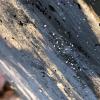
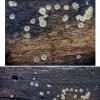
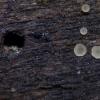
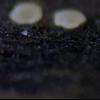
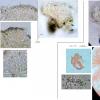
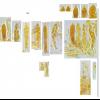
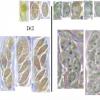
 Sections-0001.jpeg
Sections-0001.jpeg